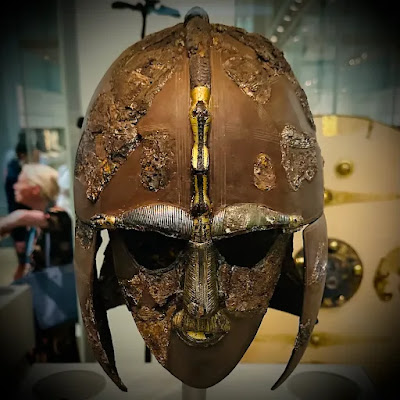From Joshua Trevino at Armas:
ShareThe end of Christian iconography in the old sites and realm of English Catholicism does not mean the end of iconography. Quite the opposite: the new religion clambers upon the ruined edifice of the old and apes its forms. Among the American misapprehensions of Britain is that it is becoming Islamic. That is in fact happening — it is notable that a mosque is the only religious structure seen on the train from London to Oxford — but it is consequence rather than cause. Islam did not eradicate Christian England: that was the work of the English themselves, who at some point in the twentieth century decided to adopt wholesale American-style propositionalism as the basis of the nation — even unto their own ruin — and thereby cut themselves off from all they had been and meant. Surrendering the past is surrendering the future for which past is prerequisite.
Yet there is still iconography. The Anglo-Saxon England of one thousand years ago in which the small parish of St Benedict was erected, stone tower and all, was replete with iconography. Men and women alike encountered imagery of the saints, of the faith, of Christ as a matter of routine in their lives. Today the images remain, and today they are encountered daily, but they are of something else entirely. We walked through an Underground station whose long dirty white corridors were decorated with easily hundreds of images of London’s “queer” population. Each icon — let us use the word, for this was the intent — contained a headshot of some sort, with explanatory text below. One of them struck me and exemplified the rest: a man named Fotis, whose pronouns are Ve / Vir. Elsewhere in a train station, we encountered an image of two African women in passionate embrace: its caption reminded the passer-by that “loving who you choose” is what makes Britain Britain. Of course it does not, but it is a purposeful substitution of the new and confected nation for the old and rooted one. The new religion clambers upon the ruined edifice of the old and apes its forms
All this is tutelage, of course. The images of Fotis the Ve / Vir and the like pervade the public square in London for instructional purposes. They teach the English their new narrative, their new understanding of self, and their new permitted ambit of thought and belief. In Trafalagar Square, after telling my son about Nelson, I noted that the crossing lights throughout the busy intersections were not the usual green-and-red walking men. Instead they were sex symbols: literally so, two male symbols intertwined on some crossing lights, two female symbols interlocked on others, and (less common) a male symbol and a female one paired. The regime narrative is that this is intrinsically British, and therefore belongs in a quintessentially British space — never mind Nelson’s own fervent Christianity, which never encompassed whatever this is — and every other space besides. If you thought you were getting away from it while crossing a street, think again. The method is relentless and pervasive, and it works. At Bletchley Park, scene of some of the most intrepid intellectual work of the Second World War, an Englishwoman of a certain age asked me what I thought of it all — and then delivered an apologetic monologue for Britain’s treatment of Alan Turing, as if that was at all the centerpiece of the history there. Yet for her it was. I chose not to share my own view, which was that Alan Turing, whatever injustice done him, was dispensable to the survival of civilization, but the mores he transgressed were not. It is not that I mind the argument, but the argument is impossible: to paraphrase Rod Dreher, we have lost our reason and can no longer discern.
This too is a regime choice.
J.R.R. Tolkien in his work has Galadriel say that “together through ages of the world we have fought the long defeat,” and this is his England now. We entered the chapel at Oxford’s Exeter College to see the bust of Tolkien there. Though he never worshipped on the premises, it is not the first Anglican appropriation of Catholic glory. There, at the rear of the chapel, behind the golden crucifix, is a large LGBTQIA+ flag. Sir Steven Runciman, in his magisterial Crusading history, records that the Patriarch Sophronius, upon seeing the conquering Caliph Omar enter the Temple Mount, murmured through tears, “Behold the abomination of desolation, spoken of by Daniel the prophet.” But the Patriarch was premature on the matter of the apocalypse, and neither Caliph Omar nor any Muslim has desecrated the church at Exeter College. The long defeat is a grappling with the enemies of the English who are the alienated sons of the English themselves. (Read more.)


















No comments:
Post a Comment